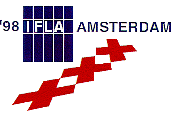
As of 22 April 2009 this website is 'frozen' in time — see the current IFLA websites
This old website and all of its content will stay on as archive – http://archive.ifla.org

As of 22 April 2009 this website is 'frozen' in time — see the current IFLA websites
This old website and all of its content will stay on as archive – http://archive.ifla.org




alt="Chart" width="569" height="393"

In February 1960 the Task Force published its final report (1). Its first recommendation was that 'A "standard version" of ca 60,000 subdivision, in English, in machine readable format should be created. It should be supported by a semantic network and have a much more consistently faceted structure than at present'. To give an idea how much 60,000 subdivisions are: the full edition of the UDC had about 200,000 subdivisions in 1990, the than existing medium editions about 40,000. The last edition of the Dewey Decimal Classification has about 30,000 subdivisions.
Later in 1990 the Management Board accepted the final report. How the first version of what came known as the UDC Master Reference File (UDC-MRF) was built I have described elsewhere and should not repeated here (2). In this paper I describe the structure of the MRF database as it exist now. Further I want to emphasise the possibilities of the UDC-MRF.


Most records are quite simple, containing only a 001 field and a 100 field, sometimes completed with a 105 and/or a 125 field (see Figure 1). A more complicated record is given in Figure 2.
The standard indexing as done in The Hague gives the possibility to search on UDC numbers or on words of the description. This adds nothing compared with a printed edition with a good index, such as the British Medium Edition of 1993. A good index gives even more synonyms, including synonyms not given in the MRF. An index also can deal with the problem that the terminology is not always consistent. Searching with SALARY + SALARIES gives 14 records; searching with WAGE + WAGES results in 59 records. Of the 14 records found with SALARY + SALARIES 9 do not also contain the term WAGE or WAGES. And to find all notations, which deal with pay in way or another, we have to search with PAY$ too! There exists a record with Pay restriction as description.
The database gives also new search possibilities. A multilingual edition is quite simple to make when the different translations are available (see Figure 3) (5).
For the indexer or the end user it is important that it is possible to search with the words in the descriptions of examples. The UDC editions contain many examples of combinations of notations and parallel subdivisions and they can be found in this way.
There are however two shortcomings. In the record for a given notation one can not find which special auxiliaries are valid for that notation and also the next notation higher up in the hierarchical chain is not given.
Which special auxiliaries are valid for a notation is not always clear. In theory one can find the answer by going up in the hierarchical chain. The special auxiliaries are given under the hierarchical highest notation where they are valid and can also be used for all subdivisions. However, especially in class 6 -- where there are many special auxiliaries -many irregularities exist. These can make it difficult to know which special auxiliaries are valid. In the record for 616 is a note saying that the special auxiliaries given under 616 are valid also for 617 and 618. Under 617 and 618 there is no reference to these special auxiliaries (see Figuur 4 and Figure 5).
In most cases it is uncomplicated to find the next notation in a hierarchical chain: each level is denoted by one digit more or less in the hierarchical chain. There are however many exceptions. The irregularities in class 2 are well known (see Figure 8) but there are many other instances.
For the reviser it is important that it is possible to find all instances where a given UDC number is present in the database. Not only as a main number but also as an example or a part of a combination of notations. When in a revision the UDC number 625.768.7 is replaced with another number the notation has also to be changed in the record for 628.1.034.4 (see Figure 6). Note that the special auxiliary .034.4 is not given in the combination field. The description For fire fighting is the description for 614.84.034.4). Also notation more or less hidden in a combination of notations can be found through the index. For this purpose there exist a special field (field 951, see Figure 7).
It can be used for breaking complex notations in there constituting parts. Decomposition is not always possible without looking up in the tables. In this way it is possible to search on all separate notations that together form the notation given to a book (7). Only with a form of decomposition of the complex notations it is possible to find all documents dealing with auxiliaries. Two examples: (498) Romania and Evening study. Evening school (37… 018.2).
When the separate parts are available for searching than the next step is using the descriptions, which belong to a notation, for the search process. In an ideal situation the end user can search without using one notation. Condition is a modernisation of the terminology and the adding of synonyms. This searching with words instead of with notations can be combined with navigation. Navigation enables the searcher to ask for documents that are like a given found document, or to search for all documents dealing with a subject, including documents dealing with a subject hierarchically lower in the change.